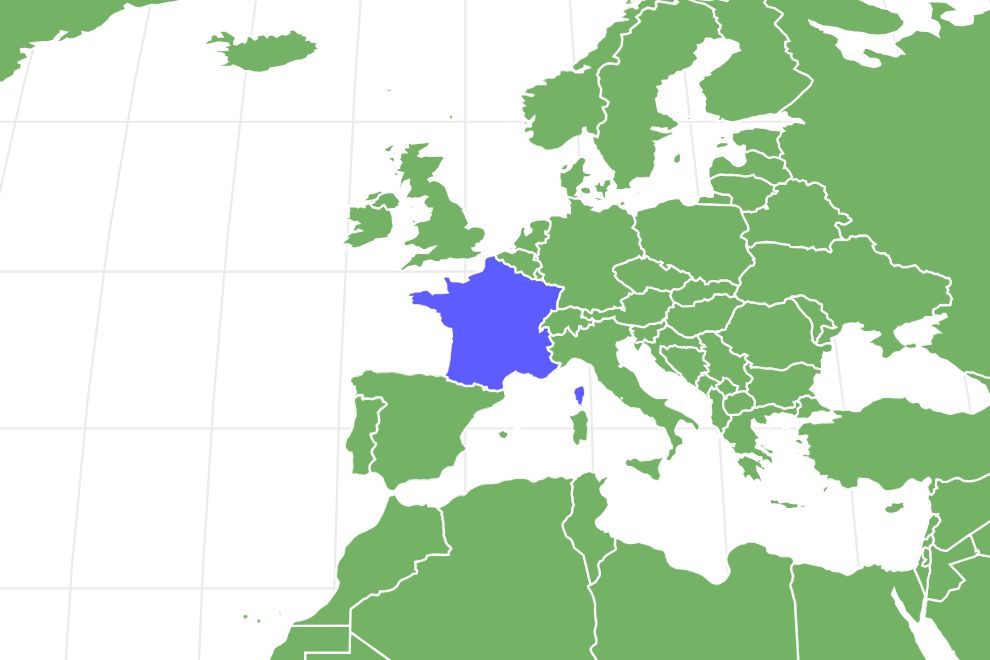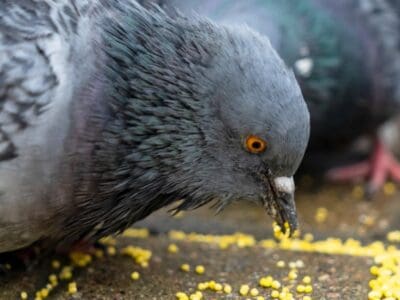Brittany
Canis lupus
The breed was formerly known as the Brittany spaniel
Advertisement
Brittany Scientific Classification
- Kingdom
- Animalia
- Phylum
- Chordata
- Class
- Mammalia
- Order
- Carnivora
- Family
- Canidae
- Genus
- Canis
- Scientific Name
- Canis lupus
Read our Complete Guide to Classification of Animals.
Brittany Conservation Status
Brittany Facts
- Fun Fact
- The breed was formerly known as the Brittany spaniel
- Temperament
- Upbeat, friendly, and sensitive
- Diet
- Omnivore
Brittany as a Pet:
- General Health
- Energy Level
- Shedability
- Trainability
- Intelligence
- Tendency to Chew
- Size
- Family and kid friendliness
- Yappiness / Barking
- Moderate
- Separation Anxiety
- High
- Preferred Temperature
- Average climate
- Exercise Needs
- High
- Friendly With Other Dogs
- High
- Pure bred cost to own
- $700 on average
- Dog group
- Sporting
- Male weight
- 30-40 lbs
- Female weight
- 30-40 lbs
This post may contain affiliate links to our partners like Chewy, Amazon, and others. Purchasing through these helps us further the A-Z Animals mission to educate about the world's species.
View all of the Brittany images!
The first references to the Brittany’s existence come from paintings and tapestries of the 17th century.
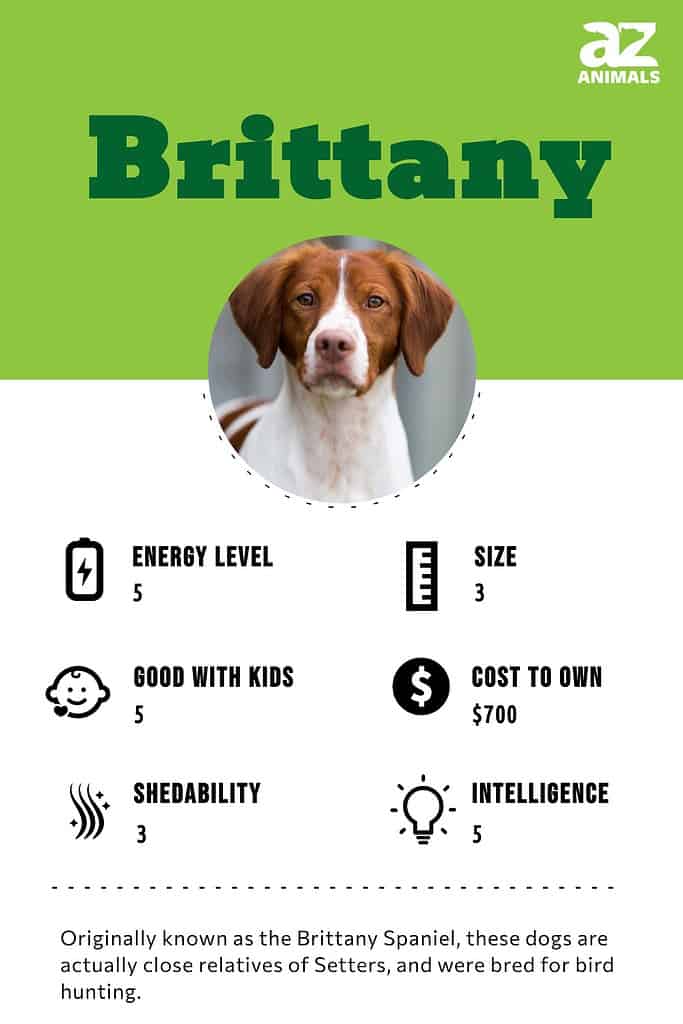
Key Points:
- The Brittany breed is a type of pointer dog that has a talent for hunting various types of fowl. Brittanys are friendly and fun pets who have a sensitive nature and do well with lots of positive affirmation.
- Brittanys are fairly easy to care for, but have a lot of energy and can be hyper. Exercise is key to helping them stay fit and happy.
- As they age, Brittanys can be prone to certain types of health issues like Cataracts, Hypothyroidism, Cancer, Epilepsy, and Hip Dysplasia.
Origin
Named after the northwestern French region in which it was first developed, the Brittany is a sturdy and robust hunting dog that specializes in different types of fowl including ducks, woodcocks, partridges, and pheasants. It originated between the 17th and 19th centuries, perhaps first used by peasants and poachers in France. The breed was once called the Brittany spaniel. However, since this dog is a pointer and does not flush out the game like a spaniel, the full name was eventually shortened in 1982 to its more accurate form. Today, it is considered to be an all-around versatile dog: good in the field, good in the show ring, and good at home as a loving companion.
See all of our expert product reviews.
Color and Markings
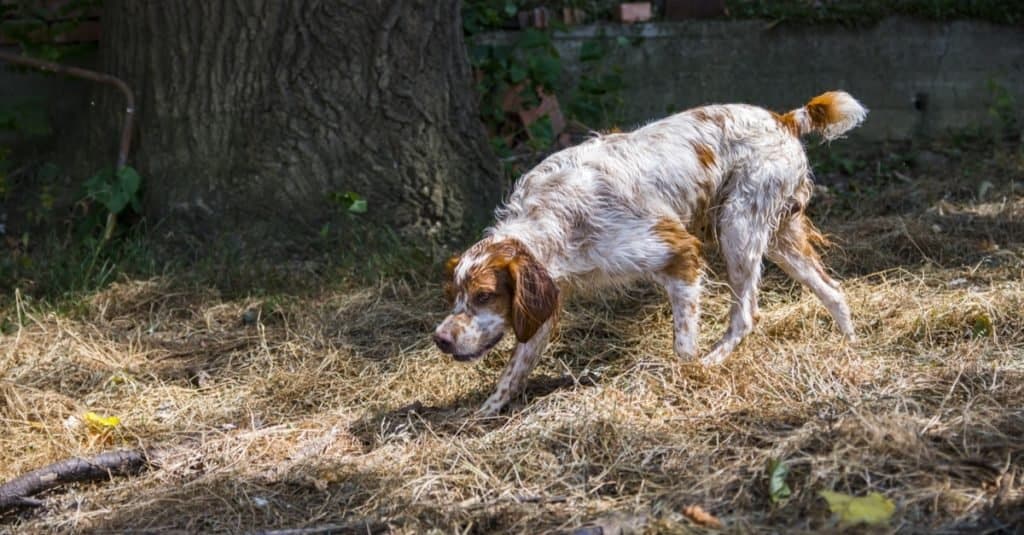
Brittany dogs are known for their big droopy ears and white-and-brown fur.
©Marko25/Shutterstock.com
In terms of its physical attributes, the Brittany is characterized by floppy ears, a short bobbed tail, and featherings around the ears and legs. It also has a flat or wavy coat of fur colored orange and white or liver and white. Their coats either have varied patterns, including parti-color (2 or more distinct, broken colors, one being white), piebald pattern (covered with patches of 2 colors), a clear pattern, or a roan pattern (a mix of colored hairs with white hairs, which can appear as freckling or ticking).
Types of Brittany
There are generally two types of Brittany dogs: American and French. The only difference between them is that the American Brittany is larger and faster.
3 Pros and Cons of Owning a Brittany
| Pros! | Cons! |
|---|---|
| Active and Alert The Brittany is a great choice for owners who want a fun and engaging companion. | High Separation Anxiety The Brittany cannot be left alone for long periods of time. |
| Eager to Please The Brittany always seeks affirmation from its owner. | Hyperactive The Brittany is not a good choice for people who want a calm and measured dog. |
| Easy to Groom The breed’s coat is relatively easy to maintain. It is great for owners who don’t want to deal with a lot of messiness. | Sensitive Nature This breed does not do well in tense or stressful situations and environments. |

©Skumer/Shutterstock.com
Health and Entertainment for your Brittany
See all of our expert product reviews.
Size and Weight
The Brittany is a medium-sized dog with a compact and athletic frame. Its leggy build contributes to its agility and stamina. A Brittany is comparable in size to an English Springer Spaniel, though the Springer Spaniel is a bit taller. Male and female Brittanys are very similar in size.
| Height (Male) | 17.5 to 20.5 inches |
| Height (Female) | 17.5 to 20.5 inches |
| Weight (Male) | 30 to 40 pounds |
| Weight (Female) | 30 to 40 pounds |
Common Health Issues

Rabies vaccinations are especially important for hunting dogs.
©Elmira Yu/Shutterstock.com
The Brittany is a very healthy dog, an excellent choice for owners who put a premium on longevity and quality of life. Brittanys do have a few health conditions that they are prone to, including:
Cataracts
Hypothyroidism
Cancer
Epilepsy
Hip Dysplasia
Cataracts
One health condition that can be hereditary in Brittanys, or come as a result of diabetes, is cataracts. When the lenses of a human’s or animal’s eyes become cloudy or opaque, this condition is called cataracts. The degree to which they cover the eyes determines their effects on your dog. 30% or less coverage would allow your dog to see normally. If 60% or more of the lens is covered, your dog would have some visual impairment. Unfortunately, if 100% of the eye lenses are covered in cataracts, blindness would occur.
For breeds that are prone to cataracts, there are no clear preventative measures that dog owners can take. But as with humans, dogs can also benefit from cataract surgery, which can bring them back to a point of seeing well enough to lead normal lives. You would need to consult with your dog’s vet on the options.
Hypothyroidism
A Brittany can also develop hypothyroidism, a condition caused by low levels of hormones produced by the thyroid gland. Symptoms of this disease are lethargy, obesity, flaky skin, hair loss and brittle fur, and an irregular heartbeat.
If your dog is diagnosed with hypothyroidism, it will likely have to be on medication for life. The disease is treated with a thyroid replacement hormone such as the manmade hormone called levothyroxine or L-thyroxine.
Cancer
Many dog breeds are prone to cancer, but the type of cancer can vary. For Brittany Spaniels, the most common type of cancer that they are prone to is Liposarcoma (Lipoma). A lipoma is a benign fatty skin tumor found on dogs, commonly occurring on their legs, chest, or abdomen. These tumors can grow large, and some can grow between a dog’s muscle layers. The malignant kind is called a Liposarcoma.
Lipomas are typically removed surgically, though some veterinarians choose to monitor their size. They can limit a dog’s mobility, and can even be painful. Cancerous liposarcomas may be treated with surgical removal and radiation. It’s important, if your dog has one or more of these tumors, to keep an eye on them for changes in size or how they feel (soft and squishy vs. hard). Always consult your vet for advice if you detect a lipoma on your dog.
Epilepsy
Epilepsy is another hereditary condition that can occur in Brittanys and many other pure breed dogs. Epilepsy is a neurological disorder characterized by unprovoked, recurring seizures.
While seizures can be frightening to you, your dog does not experience pain during one, and it usually lasts less than a few minutes. If the seizure lasts longer than 3 minutes, take it to the vet as soon as possible. Once a dog has one seizure, more will likely follow, so life-long medication will be the most likely treatment your vet prescribes. If your dog has a seizure, avoid getting near it’s mouth as you may get bitten. Otherwise, make sure your dog is clear or objects it could injure itself knocking against, and watch it till the seizure subsides.
Hip Dysplasia
Finally, a serious issue that a Brittany could face is hip dysplasia, a developmental disorder in which a deformed hip joint becomes partially or fully dislocated. This condition can cause walking abnormalities, pain in the hip or joints, instability in the hip, and even lameness. In severe cases, surgery may be necessary to correct this problem.
While some dogs will inevitably develop this condition, there are some things a pet owner can do for long-term prevention of hip dysplasia.
- Diet: Keep your dog on a healthy diet throughout its life, feeding it a trusted brand of dog food that contains vitamins and nutrients, high-quality meat, and healthy carbohydrates, with no chemicals or meat byproducts.
- Weight Management: If raising your Brittany from a puppy, help to keep it lean rather than allowing it to put on excess weight from a young age. Avoid over-feeding, and keep an eye on its weight range, consulting a vet if your dog appears to be overweight.
- Exercise: Look for ways to keep your adult dog active like walking it, hiking, or doing activities that encourage it to run. However, when raising a Brittany puppy, it’s important not to overwork its bones and joints in the developmental stage. It’s recommended to discourage jumping and running in young puppies, which can cause issues that can lead to hip dysplasia later on.
- Avoid jumping: Even as an adult, the one physical activity that can set the stage for future hip dysplasia is jumping too much. Frisbee or jumping for balls can actually do more harm than good. Rely on safer exercises like running, walking, and even swimming.
- You can consult your dog’s veterinarian and put it on supplements that contain vitamins C and E, as well as other vital ingredients that can keep your dog’s bones and joints healthy.
An average Brittany will live somewhere between 12 and 14 years old. While there is always an element of randomness and luck to health, the chances of a long life can be improved by a good diet, proper weight, an active lifestyle, high-quality healthcare, and a good genetic pedigree. You should always ask the breeder to provide proof that their dogs are checked and cleared for common genetic conditions; this is standard practice for a good breeder who cares for the health of their dogs.
How to Take Care of the Brittany

Brittany dogs make great companions for hunters and vegans alike.
©cynoclub/Shutterstock.com
The Brittany is a very versatile breed; one does not necessarily need to be a hunter to enjoy it. However, this breed will do best with outdoor lovers and adventurous types. It may struggle with apartment living unless you’re prepared to spend a lot of time outdoors in nearby open areas or parks.
Besides its enormous exercise requirements, many other aspects of its care are relatively straightforward and easy. Grooming in particular should not take up too much of your time. If you have any other questions or concerns about your dog’s care, then you should consult with your vet.
The Best Dog Food for the Brittany

Dog foods that support the Brittany’s immune system are vital for their longterm health.
©sophiecat/Shutterstock.com
Depending the dog’s age, activity level, and size, the Brittany probably needs about 1.5 to 2 cups of high-quality dry food a day with lots of protein. Owners should not leave out food during the day, because this breed might have a tendency to gain weight. Two smaller meals spaced several hours apart should be sufficient to feed your dog.
A-Z Animals believes that the best dog food for the Brittany is Stella & Chewy’s Wild Red Classic Kibble Dry Dog Food.
The high-protein content of this food comes from 83% quality meat sources, with less filler that may trigger those dramatic blood sugar fluctuations and leave your Brittany hungry for more food. There’s taurine for clear eyes, glucosamine for sturdy joints, and plenty of nervous system and immune system supporting omega 3s for wellness from the inside out.
Try out Stella and Chewy’s Wild Red Classic Kibble, available on Chewy or Amazon
- Packed full of protein with beef, pork, and lamb
- Crafted without legumes or poultry
- 81% of protein is from actual animal sources
- "Whole prey” ingredients including muscle meat, organ meat, and cartilage
- No fillers, artificial colors, artificial flavors, or preservatives.
Maintenance and Grooming
Maintenance for this breed should be relatively straightforward and easy. A short grooming session with a soft brush two or three times a week, combined with a comb-through of the featherings, should suffice to keep this dog’s coat healthy and clean, and free of tangles, even in the shedding season.
For some show dogs, additional trimming may be necessary around the head and neck area. Other important aspects of this dog’s care include monthly nail trims, regular ear checks, and teeth brushes about two or three times a week with an appropriate paste.
Training
The Brittany is an intelligent and trainable dog that should pick up easily on a wide variety of different human commands. Because of its sensitive nature, owners need to be extra calm and relaxed around this breed. Positive reinforcement methods and encouragement work best. Do not raise your voice or show it any anger. If you need help with the process, then you should contact a local trainer in your area.
Exercise
The Brittany was intended to be an outdoor dog of seemingly boundless energy, so an adult needs at least an hour of exercise every day. Simply taking it on walks will not suffice, however. It will need plenty of room off the leash to run around and play. This can be combined with other games, toys, and even flyball or agility challenges. Exercise time should be limited to no more than half an hour in dogs younger than two years of age.
Puppies
Like any breed, the first few months of the Brittany’s life are crucial for its social and mental development. Some puppies may exhibit overly timid or submissive behavior with a tendency to urinate when becoming overly excited or scared. Early training and socialization should help to shape the puppies into confident and well-behaved adults. Owners should also consider crating the puppy to assist with behavioral issues or house training problems.

©Barbara_C/Shutterstock.com
The Brittany and Children
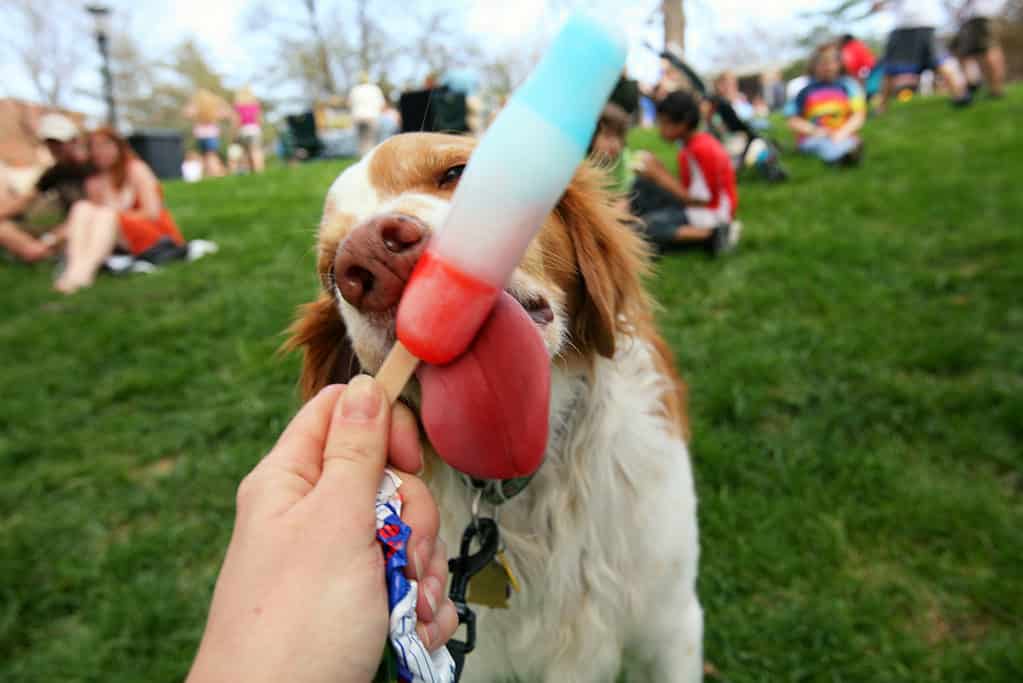
Brittany dogs make great pets for older kids.
©iStock.com/Jennifer Roberts
The Brittany is a good choice for children who spend a lot of time outside and want a good-natured companion. Because of its sensitive nature, however, it might not do particularly well with younger children who like to play rough and make a lot of noise.
Similar Breeds
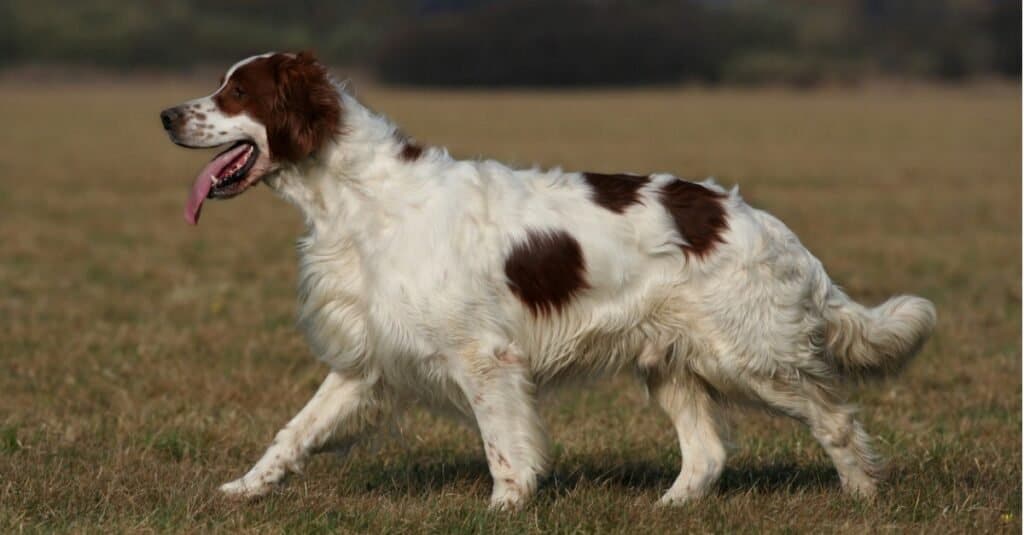
Irish Setters are closely related to the Brittany.
©iStock.com/Wavetop
The Brittany bears the strongest similarities to the pointers and gundogs of Western Europe. With that in mind, you might want to check out some of the following relatives to the Brittany:
- English Setter – Developed in the 19th century, the modern English setter is a hunting dog that would quietly freeze and point when it located a game bird. Provided they receive enough exercise, these friendly, calm, and good-natured dogs also make great companions for the entire family.
- Irish Setter – Like its English relatives, the Irish setter is a high-spirited hunting dog with long, droopy ears and a dark red or chestnut coat of fur. Beloved by many owners, this is a particularly popular dog in the show ring. It has won the sporting group competition at the Westminster Kennel Club 11 times.
- Braque Saint-Germain – Also known as the St. Germain pointing dog, this active and upbeat hunting breed is somewhat obscure outside of its native France. It’s recognized by the United Kennel Club but not the American Kennel Club. The Saint-Germain are close relatives of other French hunting dogs or gundogs.
Famous Dogs
While the Brittany is a somewhat obscure breed outside of hunting circles and show rings, there are a few individuals that have managed to stand out for their talent. For instance, a Brittany by the name of Tally won the 2010 Westminster sporting group. Another Brittany called Jester (or the more amusing name, Sir-ly You Jest) won the same competition in 2002 and 2003.
Popular Names

Hunter, Bailey and Buster are some of the most common Brittany names.
©iStock.com/Tatjana Vujnović
If you’re still searching for a good dog name, then you might want to consider one of the following options:
- Charlie
- Jack
- Hunter
- Beau
- Hannah
- Bailey
- Felix
- Buster
- Toby
- Buddy
National Breeder and Breeder Resources
For all kinds of information on your Brittany, you can visit the American Brittany Club.
Another great resource for those interested in adopting a Brittany is the NBRAN (National Brittany Rescue & Adoption Network).
Related Images

Brittanys specialize in hunting woodcocks, partridges, ducks, and pheasants.
©Elmira Yu/Shutterstock.com
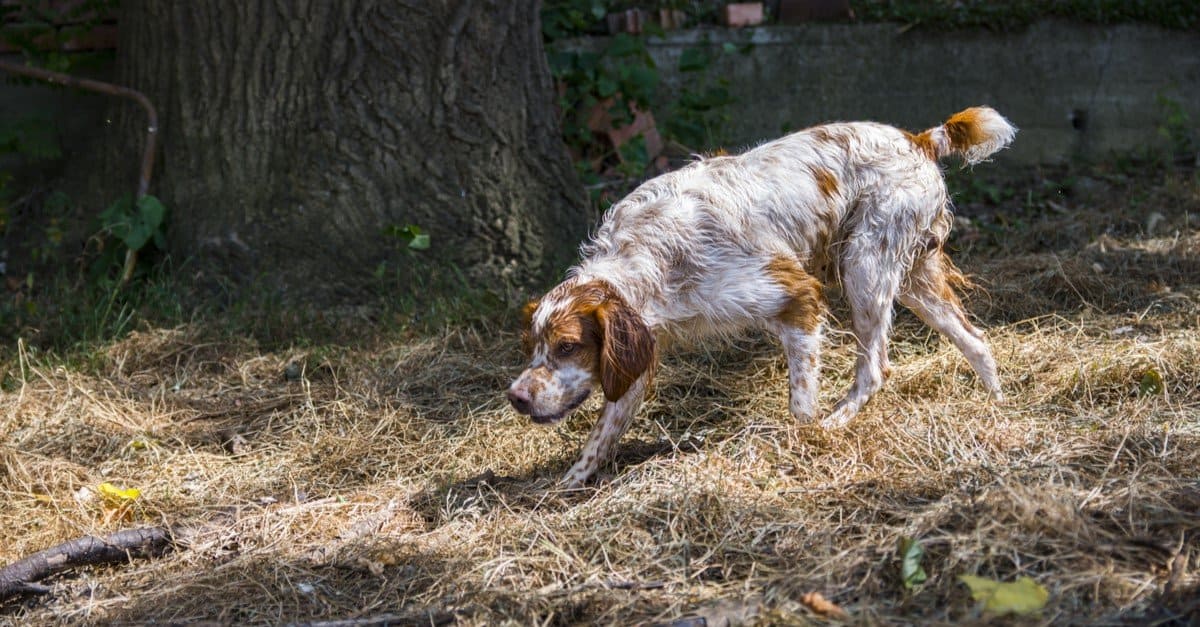
A Brittany hunting dog following a scent.
©Marko25/Shutterstock.com

Brittanys are fun and engaging, and seek affirmation from their owners.
©cynoclub/Shutterstock.com
Other Articles
If you enjoyed learning about the Brittany, read on for more information on dog breeds:
- Meet The “Gray Ghost”: The Lovable Weimaraner Learn interesting facts about Weimaraners.
- Meet the Amazing Chihuahua! Chihuahuas may be small, but they can hold their own in any canine crowd. Learn more about them in this article.
- Let’s Discover The Joyful Life A Labradoodle Breeds crossed with poodles are gaining popularity. Find out all you wanted to know about the Labradoodle.
Brittany FAQs (Frequently Asked Questions)
Where can I adopt a Brittany?
If you’re interested in adopting this breed, then you can check with several Brittany-specific rescue groups, including American Brittany Rescue and the National Brittany Rescue and Adoption Network. It may be more difficult to find one at a general animal shelter.
Are Brittany dogs good family dogs?
Yes, the Brittany is an excellent family dog. It gets along very well with people of all ages, though it might be a little sensitive to loud noises and rough behavior.
Do Brittany dogs shed?
Yes, this dog might do a bit of shedding, but as long as owners brush the fur at least twice a week, most of the loose hair should be taken care of.
Are Brittany dogs cuddly?
The Brittany is a very affectionate breed. Properly socialized dogs should thrive on constant human contact and attention.
Are Brittany dogs smart?
Yes, the Brittany is well-regarded for its intelligence. Out in the field, it needed to be a sharp-minded and inquisitive breed in order to alert its owner to the presence of game birds. In the home, it’s quick to grasp and follow human commands.
What does a Brittany look like?
The Brittany is a medium-sized dog with a solid, compact, and athletic body. Some of its most iconic features include floppy ears, a short bobbed tail, and featherings around the ears and legs. The coat of fur is always flat or wavy with an orange and white or a liver and white coloration.
What are some types of Brittany mixes?
Some popular hybrids include a Labrador Retriever mix (a Labany), a Border Collie mix (a Border Collie Britt), and a Beagle mix (a Brittany Beagle).
What are the differences between Springer Spaniels and Brittany?
The biggest differences between a Brittany and a springer spaniel are their size, country of origin for the breed, and morphology.
Thank you for reading! Have some feedback for us? Contact the AZ Animals editorial team.
Sources
- American Kennel Club, Available here: https://www.akc.org/dog-breeds/brittany/
- Furry Friends Gear, Available here: https://www.furryfriendsgear.com/dogbreeds/brittany/
- The Spruce Pets, Available here: https://www.thesprucepets.com/brittany-dog-4584350

